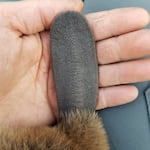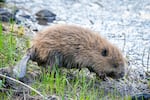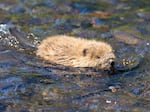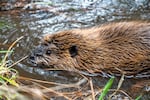When a baby beaver showed up in the drive-thru lane of an Eastern Oregon coffee shop early one morning in May, no one knew what to do.
“Holy crap, it’s a beaver,” Café Manager Jamie Rigel remembered thinking as she approached the mound of fur with a paddle-like tail.
The café in John Day was busy that morning, and a steady line of drivers didn’t seem to notice anything out of the ordinary as they rolled past the tiny, cowering beaver. Rigel and a co-worker scooped the animal off the pavement and into a sweatshirt, making a bundle that reminded Rigel of holding a newborn kitten.
“You could tell it was cold and tired,” she said. “We kept looking for mom, and we waited for a while. No sign of her, no sign of any other babies, nothing,” she said.
Rigel suspects flooding flushed the little beaver out of a den in the nearby John Day River. Heavy rains had recently supercharged its flows, inundating a slough across the street from the coffee shop.
The beaver’s mysterious appearance set off a chain reaction of human interventions, from being picked up in the parking lot, to being kept in a bathtub, riding in a police cruiser, and finally living in a bespoke enclosure at a museum that hopes she will thrive among people.
Rigel said she contacted local law enforcement, but they couldn’t help. Then, she left messages with the Oregon Department of Fish and Wildlife. After a couple of hours, a resident with a reputation for caring for injured wildlife took over.
“It was a very difficult experience to make it so that [the beaver] would survive. And I had to fight a lot of people about it,” said Sue Malaney, who put the animal in her bathtub with some branches, rags and a pet bed.
Malaney texted wildlife experts at a rehabilitation center in Bend, hoping they would take the beaver. The center urged her to look for signs of others along the river, and try to reunite the baby with its family. It’s illegal in Oregon for people to take in wild animals. When state wildlife officials eventually contacted Malaney, she didn’t trust what they told her.
“They said her best chance of survival is to put her back in the river,” Malaney said. “I’m like, ‘No, I might as well just kill her.’”
ODFW offered another arrangement. The agency sent an Oregon State Police officer to pick up the beaver, Malaney said. He drove the animal to the High Desert Museum a few hours away in Bend. The museum cares for more than 100 animals that are unlikely to survive in the wild.
The journey raises ethical dilemmas that are becoming more common as more wildlife face habitat destruction and the consequences of human-driven climate change, said philosopher Erin McKenna, who teaches a course in wildlife ethics at the University of Oregon.
McKenna said she understands why state rules are black and white — to prevent diseases from spreading, for example. Still, when people find wild animals in distress, the calculations are often more nuanced.
“The beaver is a good example of a species that we clearly impacted, especially in the Northwest, and so many [people] would feel we have an obligation,” McKenna said.
Before beavers were widely recognized as keystone species whose dams create vital habitats for other animals, their numbers were decimated by humans trapping them for their fur and hunting them as pests responsible for unwanted flooding. Now, natural resource managers are looking to the recovering species to help save endangered salmon and reach climate action goals.
“I think more people understand that we shouldn’t go capture animals to bring them into captivity, but if they’re orphaned or hurt and need help, I think a lot more people think that is an OK intervention, even if it means they’re then cut off from their kind for the rest of their life,” McKenna said.
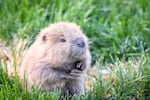
In this supplied photo, a baby beaver, called a kit, was found alone, weak and dehydrated in a parking lot in John Day.
Courtesy of Jon Nelson/ High Desert Museum
This particular baby beaver is the first and only of her species at the High Desert Museum, where staff hope she will eventually serve as an “ambassador” for conservation education, helping people learn about the critical role beavers play in ecosystem health.
State officials determined she wasn’t releasable and would require human care to survive, said Jon Nelson, the museum’s curator of wildlife.
“We jumped on the opportunity just to try to save her life and give her a good life moving forward,” Nelson said.
The two-week-old animal was near death when she arrived at the museum, and her caretakers grappled with how to feed her a natural diet, and how to ease her painfully bloated belly.
“I have about 20 years of experience caring for animals… and this was the hardest one that I have ever done,” Nelson said. “For the first few weeks, every single time she defecated it was exciting.”
After a period of round-the-clock care, the beaver’s health improved. In six months, she grew from weighing just over 1 pound to nearly 18 pounds.
This month, with her health on more steady footing, the museum announced its newest resident publicly with cute photos and videos.
Earlier this year the museum auctioned off the right to name the beaver, but the winner hasn’t made a decision. For now, Nelson said some staff use a nickname coined by the young son of their veterinarian: “Beavie.”
“She likes her belly rubbed,” he said. “Beavers are social in the wild, so that’s not really all that surprising.”
Beavie isn’t on display yet, but the hope is that she will keep acclimating well to a life lived among humans, and eventually become their teacher.

